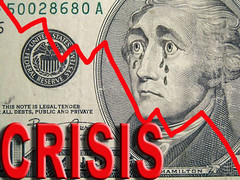Today I am republishing part of a series of articles I wrote back in May, 2008. Since then Wordout has added hundreds of new readers, and I hope they find this further insight helpful.
This was before Fannie and Freddie, before Lehman and the whole October surprise. But the general gist of it still applies.
 Image by MotherPie via FlickrCrisis? What Crisis?
Image by MotherPie via FlickrCrisis? What Crisis?
The subprime mortgage crisis is a problem for all of us. Whether you’re in Asia, Europe, Africa, one of the Americas or Australia, you’re already affected. Rising costs in everyday things like gas, food and clothes are worldwide. And the subprime crisis is right in the middle of it.
CDOs were first created in 1987 by Drexel Burnham Lambert. If you remember the stock market crash of 1987, you might recall that afterwards there were several investigations into the marketing of “junk bonds”. DBL was famous for their part in that. So CDOs were not really all that new, but generally they weren’t used with mortgages. Researching at RiskGlossary.com, we find:
CDOs are mostly about repackaging and transferring credit risk. While it is possible to issue a CDO backed entirely by high-quality bonds, the structure is more relevant for collateral comprised partially or entirely of marginal obligations.
Marginal obligations. That’s polite for bad loans. The way it would usually work is this: Lots of “marginal obligations” would get bundled together with a few reasonable ones and a very few highly rated ones. That bundle would be bundled with other bundles, created with a similar mix with the added dividend of several low quality bundles and at least one with a high rating. That mega bundle would get a high rating. Then the bundles would be “pooled”. Then these pools would be pooled. Then you take slices from bunches of these pools and and that makes a CDO.
If the CDO has at least one top rated, AAA pool slice, then the CDO has that rating. A quick slang primer: “Money good” is highly rated and everyone believes it’s guaranteed profit with no risk. “Toxic Waste”, well, you get the picture. What was happening was that there was alot of toxic waste being sold as money good, and at least some of the people knew it. But not the investors.
By now, which was around 2005, the investors weren’t just from overseas. The housing boom was so historic that it spawned television shows well into 2007. People who had never invested in anything felt fine investing in a house, or two. And those who didn’t join in the housing frenzy? If they held shares in money markets, their managers were happily buying up pieces of these CDOs.
Breakfast In America
By 2005 you could buy a house with no money down and resell it a year later for twice the price. For some reason everybody thought prices would only go up. And since anybody could get a loan, many did. By 2005 the average home cost 4 times the annual income of the average family. For most of our history, it’s been only 2 times the income.
But many who were able to get a loan were having trouble making the payments. Prices had skyrocketed, causing monthly mortgage payments to increase. It soon became obvious that just because someone could get a mortgage didn’t mean they could pay it off. The CDOs were supposed to spread the risk out so thin that no investor would be damaged if it performed badly. With so many CDOs filled with toxic waste, there were few that weren’t damaged, magnifying the risk.
People were getting loans, buying the house, moving in, and then defaulting on the first payment. It was a trend in 2006. The first to notice that anything was wrong were the biggest managers of all these CDOs. They noticed that even though the computer software showed acceptable risks, the actual performance was not what was projected by the computer models. Looking into the details, they found that far more defaults were occurring than the computer predicted.
Crime Of The Century
As defaults piled up, property prices started declining. This was bad news for many homeowners. Many of them had already taken out ‘equity’ in their homes, in the form of a home equity loan. In essence, they’re making two house payments. With a basically flat economy, that can only last for so long. If you have a picture in your mind of some kind of lower class person just out to rip off the rest of us, you need to rethink. Most are hard working people trying to make a good life for their families.
By 2006 it was common to find people who had gotten mortgages they weren’t even looking for, sold to them by a guy who simply knocked on the door one day and offered them the American Dream. I personally know at least one person who, although he qualified for the best terms, was convinced by the local bank to take a much more expensive loan. Unethical standards were applied across the board, from the local level to the international level.
As the loan defaults continued, credit tightened up. The 1st to go was the NINA loan. With no notice at all to local mortgage companies, the larger banks and investment firms simply stopped buying them. Suddenly, billions of dollars which had been riding a fast moving gravy train were just stopped. Some banks went quietly of business. Some were bought, or “merged” with another bank to stay alive. (Sound familiar?)
It’s not just the locals though. Bear Stearns proved that. At every level the fabric has fallen apart. We’re only just beginning to see how deep the hole is. The Fed has been trying hard to keep the financial system working here in the US. Their counterparts in Europe and Asia are doing the same. For instance, during the same week that Bear Stearns was “rescued”, the Fed pumped about 200 billion dollars into the US economy. Since then, the Bank of England is having to take a look at how deeply their economy is affected. So far, they’re into it for about 100 billion dollars. The International Money Fund estimates that the total losses worldwide could reach 945 billion. If so, I’d consider us lucky. That would represent only a 1% loss of the original 70 trillion.
Even In The Quietest Moments
Right now, it’s quiet. The Fed has come in and done their thing. One of the big guys has fallen. It’s all out in the open… sort of. Remember I said at the top that no matter who you are, you’re affected? Well, here’s where we find out how. This is the part that the Fed is really fighting against, and I hope they win. I doubt that they will, but I hope.
You see, the housing and mortgage markets were performing so well that many traditionally safe investment funds began buying into these mortgage backed CDOs. They were rated AAA, money good. But they are filled with toxic waste. They are a time bomb, ticking. As long ago as April 2007, it’s been a certainty to some at the top. From Market Watch dated 4/4/2007:
…a Reuters article quoted a spokesman for a UK asset management firm, “I do think a massive default cycle is about to start in the CDO market. It’s mad. Sub-prime will create massive defaults.” “The event that will destroy the CDO market has already happened. But it will take another year to trickle down. They [holders of the CDOs] don’t realize what’s going to happen.”
The holders of those CDOs are everybody who is invested in just about any type of funds. I don’t personally own any shares in any funds, it’s never been my ‘thing’. But most people I know who have anything invested are investing at least some of their savings in funds. In a twist of irony, these are the investments we normally think of as safe.
Famous Last Words
So it’s good for us guys who have no funds, right? Not really. Think about the magnitude of the problem for a moment. Put it into perspective. The Fed pumped 200 billion dollars into the economy. That’s about 2000 dollars for every family in America(based on 3 per family and 300 million people). Did you see anything change? Did gas prices go down or up? Did your mortgage or your rent get paid any easier? Did you feel it at all?
That chunk of change, 200 billion dollars, didn’t do a thing for you did it? Trust me, it’s a drop in the bucket. That money went to keep banks from going under. And why were they needing the help? Because of the bad loans they made intentionally. The only other alternative was to let them go under en masse, and that’s not permitted anymore in the US. That’s the promise of the recession we’re in, that there will be no depression. But it will probably last long, and be hard.
I’m going to end Crunch Week on that note, and maybe this thought: Several years ago, it became known that there was about twice as much fixed income savings in the world as was thought. All that extra savings was in the hands of countries who had historically been poorer. Through the use of what would evolve to be unethical strategies, most of that savings has been transferred somewhere in the form of debt, which is what the savings really represented to begin with. If the IMF prediction above is accurate, is the end result is that somebody will have profited over 35 trillion dollars when this is over? And if so, then who was that masked man?
.
Many thanks to ThisAmericanLife for publishing the podcast which I used as source material for most of this and the last post, “The Global Mortgage Ripoff”. I didn’t even come close to covering everything they did, so if you want more information on this subject, I highly recommend listening to the entire recording. Just hover your mouse over the little yellow SnapShot and hit the play button that appears. The audio lasts about an hour.
I am Jon, and that’s my 2 cents.

To read all of the Crunch Week series, use these links:
How Much Money Is There
Bear Stearns – The BS Timeline
The Global Mortgage Ripoff
The Promise Of Recession

